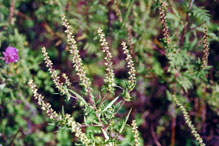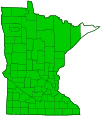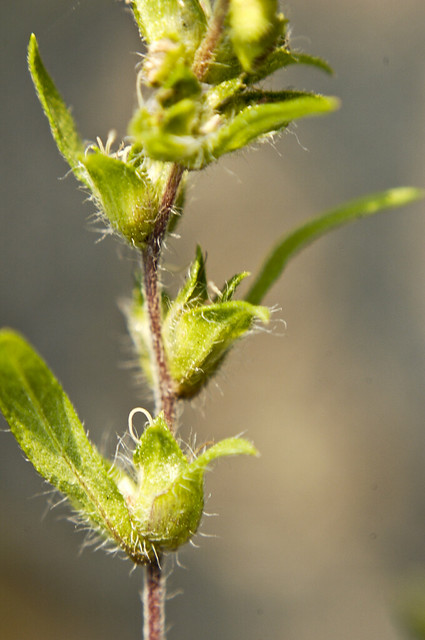common ragweed
(Ambrosia artemisiifolia)
Conservation • Wetland • Description • Habitat • Ecology • Use • Distribution • Taxonomy
Description |
||
Common ragweed is a 12″ to 40″, usually 12″ to 24″ tall, erect, annual forb that rises from a taproot. The stems are erect, bushy, frequently branched at least above the middle, and hairy. Leaves are opposite near the base, alternate above. They are deeply cut into lobes that are spaced out along the midrib but not cut to the midrib. The lobes are themselves deeply cut into lobes that are spaced out along the midrib but not cut to the midrib (the lobes are pinnatifid, the leaves are bipinnatifid). The leaves are 1″ to 3½″ long, usually no longer than 2⅛″, and ¾″ to 2″ wide, usually no wider than 1⅛″. They are wider at the base than at the tip. The upper and lower surfaces are gland-dotted and, on younger leaves, covered with stiff hairs that are either straight or appressed. Mature leaves are relatively hairless. The leaves are on stalks that can be 1″ to 2⅓″ long, but are usually no more than 1⅓″ long. There are separate male and female flowers, both borne on the same plant. Male flowers are borne in spike-like inflorescences at the ends of stems and branches. The spikes are up to 4″ long with 12 to 20 or more flower heads. The heads are green, bead-like, and about ⅛″ in diameter. They hang downward at the end of short stalks. Female flowers appear singly from upper leaf axles. Both flowers are rayless. The fruit is an achene without tufts of hair. |
||
Height |
||
12″ to 40″ |
||
Flower Color |
||
Green |
||
Similar Species |
||
Annual bursage (Ambrosia acanthicarpa) leaves are covered with white to gray, short, bristly hairs. Giant ragweed (Ambrosia trifida) is a much taller plant. Its leaves are palmately lobed. Lance-leaved ragweed (Ambrosia bidenta) leaves, as the latin name suggests, have two teeth, one on each side of the leaf. Western ragweed (Ambrosia psilostachya) leaves are pinnatifid (once cut), not bipinnatifid (twice cut). |
||
Habitat |
||
Disturbed sites |
||
Ecology |
||
Flowering |
||
August to September |
||
Pests and Diseases |
||
|
||
Use |
||
|
||
Distribution |
||||
|
Sources |
|||
| 3/30/2023 | ||||
Nativity |
||||
Native |
||||
Occurrence |
||||
Common and widespread |
||||
Taxonomy |
|||
| Kingdom | Plantae (Plants) | ||
| Division | Tracheophyta (Vascular Plants) | ||
| Subdivision | Spermatophytina (Seed Plants) | ||
| Class | Magnoliopsida (Dicots) | ||
Order |
Asterales (Sunflowers, Bellflowers, Fanflowers, and Allies) | ||
Family |
Asteraceae (Sunflowers, Daisies, Asters, and Allies) | ||
| Subfamily | Asteroideae | ||
| Tribe | Heliantheae (Sunflowers and Allies) | ||
| Subtribe | Ambrosiinae (cockleburs, ragweeds, and wild quinines) | ||
| Genus | Ambrosia (ragweeds) | ||
Subordinate Taxa |
|||
|
|||
Synonyms |
|||
Ambrosia artemisiifolia var. artemisiifolia Ambrosia artemisiifolia var. elatior Ambrosia artemisiifolia var. paniculata Ambrosia artemisiifolia var. trifida Ambrosia elatior Ambrosia glandulosa Ambrosia maritima Ambrosia monophylla Ambrosia paniculata |
|||
Common Names |
|||
annual ragweed common ragweed ragweed |
|||
Glossary
Achene
A dry, one-chambered, single-seeded seed capsule, formed from a single carpel, with the seed attached to the membranous outer layer (wall) only by the seed stalk; the wall, formed entirely from the wall of the superior ovary, does not split open at maturity, but relies on decay or predation to release the contents.
Allelopathy
The release of a chemical toxin by one plant to inhibit the growth or germination of nearby competing plants.
Axil
The upper angle where the leaf stalk meets the stem.
Bipinnatifid
Twice pinnatifid.
Palmately Lobed
Similar to a hand. Having more than three lobes that radiate from a single point at the base of the leaf.
Pinnatifid
Deeply cut, more than half way to the midrib but not to the midrib, into lobes that are spaced out along the midrib; the lobes do not form separate leaflets.
Rhizome
A horizontal, usually underground stem. It serves as a reproductive structure, producing roots below and shoots above at the nodes.
Visitor Photos |
|||||
Share your photo of this plant. |
|||||
| This button not working for you? Simply email us at info@MinnesotaSeasons.com. Attach one or more photos and, if you like, a caption. |
|||||
|
|||||
MinnesotaSeasons.com Photos |
|||||
Plant |
|||||
 |
|||||
Inflorescence |
|||||
 |
|||||

Visitor Videos |
|||
Share your video of this plant. |
|||
| This button not working for you? Simply email us at info@MinnesotaSeasons.com. Attach a video, a YouTube link, or a cloud storage link. |
|||
Other Videos |
|||
| Weed ID Ragweed crop4240 |
|||
About
Published on Oct 26, 2012 Common name: Common Ragweed Scientific name: Ambrosia artemisiifolia L. Problems: yield losses, pollen causing allergies, resistance to Glyphosate Key plant identifiers: leaves are deeply divided, heavily lobed, similar to a carrot leaf. The stem is hairy. Seeds are diamond shaped and up to 62,000 seeds may be produced. Lifecycle: Annual Propagation: Seed Not to be confused with: Canada Goldenrod. This confusion occurs because they flower at the same time and people think that Canada Goldenrod is the cause of their allergies. Location: Disturbed soils, found in Southern Ontario and North America other than Alaska, Yukon and Nunavut. Control: Most broadleaf herbicides. But resistance has been seen with Round-up so other strategies may be required such as a future soybean resistant to Dicamba. |
|||
| Common Ragweed hiddengrousefarm |
|||
About
Published on Aug 5, 2012 ID and control of common ragweed |
|||

Visitor Sightings |
|||||
Report a sighting of this plant. |
|||||
| This button not working for you? Simply email us at info@MinnesotaSeasons.com. Be sure to include a location. |
|||||
|
|||||
MinnesotaSeasons.com Sightings |
|||||
Avon Hills Forest SNA, North Unit Badoura Jack Pine Woodland SNA Bertram Chain of Lakes Regional Park Blazing Star Prairie Addition Preserve, South Unit Carpenter St. Croix Valley Nature Center Carver Highlands WMA, South Unit Charles A. Lindbergh State Park Clifton E. French Regional Park Felton Prairie SNA, Bicentennial Unit Felton Prairie SNA, Shrike Unit Hardscrabble Woods / MG Tusler Sanctuary John Peter Hoffman Spring Brook Valley WMA Kellogg Weaver Dunes SNA, Kellogg Weaver Unit Lake Alexander Woods SNA, South Unit Margherita Preserve-Audubon Prairie Mary Schmidt Crawford Woods SNA Minnesota Valley NWR, Chaska Unit Minnesota Valley NWR, Louisville Swamp Unit Minnesota Valley NWR, Rapids Lake Unit Minnesota Valley NWR, Wilkie Unit Minnesota Valley State Recreation Area, Lawrence Unit Mound Spring Prairie SNA, North Unit Mound Spring Prairie SNA, South Unit Nerstrand Big Woods State Park Northern Tallgrass Prairie NWR, Hoffman Unit Northern Tallgrass Prairie NWR, Pavia Unit Northern Tallgrass Prairie NWR, Rengstorf Unit Northern Tallgrass Prairie NWR, Spieker Unit Northern Tallgrass Prairie NWR, Touch the Sky Prairie Unit Pankratz Memorial Prairie, North Unit Pembina Trail Preserve SNA, Crookston Prairie Unit Pembina Trail Preserve SNA, Pembina Trail Unit Prairie Creek WMA, Koester Prairie Unit Richard M. & Mathilde Rice Elliott SNA |
|||||

|
Created: Last Updated: © MinnesotaSeasons.com. All rights reserved. |


